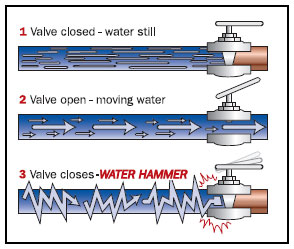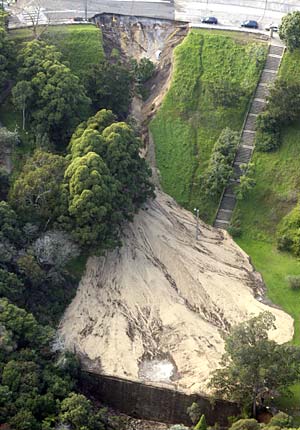Archives
Three ways to find loose pipes behind drywall
Water hammer is often caused by loose hot and cold water pipes.
Determining the location of those loose pipes in a stud wall can be challenging, but here are three methods that can help.

One method is to use a stud finder. A stud finder is a tool that can detect the location of studs, or the framing members, behind the drywall. Pipes are often run along the studs, so by finding the location of the studs, you can also determine the likely location of the pipes.
Another method is to tap on the wall and listen for a dull or hollow sound. Loose pipes will often make a rattling noise when they are tapped, whereas tight pipes will produce a solid sound. This method can be useful for locating the general area where the loose pipe is located.
A third method is to use a number of pipe location tools which are specifically designed to detect the location of pipes within walls. This collection of tools includes an electronic charge running through the pipe that emits a signal that is picked up by a sensor that’s run along the surface of the wall, which can help to locate the position of pipes with reasonable accuracy. Some listening devices can also help.
It’s important to note that it might be difficult to locate the exact spot where the pipe is loose, it’s recommended to hire a professional plumber to help you locate the problem and fix it.
Five ways to find water hammer in a stud wall.
In an earlier post we asked, “Do Hot and cold water pipes get water hammer?” Determining the location of loose pipes that cause water hammer in a stud wall can be challenging, as the pipes are typically hidden behind drywall or other wall coverings. However, there are several methods that can be used to locate the problem area:

- Sound: One of the most common ways to locate loose pipes is by listening for the sound of water hammer. This is the banging or knocking sound that occurs when a valve or faucet is quickly closed.
- Visual Inspection: If possible, removing a section of drywall or other wall covering in the area where the sound is heard can reveal the location of the pipes. You can also look for signs of water damage or staining on the wall or ceiling.
- Using a stud finder: A stud finder can be used to locate the studs behind the drywall, which will give you an idea of where the pipes are located.
- Tracer wire: If you have access to the attic or crawl space, you can trace the pipes with a tracer wire, which is a wire that is attached to the pipe and can be followed through the wall.
- Hiring a plumber: If you are unable to locate the problem area or are unsure about the best course of action, it is recommended to consult a plumber, who will have the knowledge and tools to locate the loose pipes and make necessary repairs.
Do Hot and Cold Pipes get Water Hammer?
Water hammer can occur in both hot and cold water pipes. It’s caused by a sudden change in the velocity of water flow, like when a valve or faucet is quickly closed. This sudden change in velocity can cause a pressure wave to travel through the pipe, creating the banging or knocking sound that is characteristic of water hammer.
The main cause of water hammer is water pressure that is too high, which causes the water to move too quickly through the pipes. This can happen in both hot and cold water pipes, and can be caused by a variety of factors such as worn out valves, loose pipe connections, or improper pipe installation.

In some cases, the problem is more likely to occur in hot water pipes because hot water is less dense than cold water, and therefore is more susceptible to changes in velocity. However, it is possible for water hammer to occur in both hot and cold water pipes, so it’s important to address the issue as soon as it is detected.
Read our earlier post What is Water Hammer and How to Stop It here
I can’t turn my water meter off!
If you have a plumbing emergency, or you have water running all over your house, or a split tap washer, or burst water heater and your water meter won’t turn off, you may be in trouble!
If your meter tap has a tee-head on it, turn it off in a clockwise direction as firmly as you can. Firmly; don’t overdo it.
If your meter tap is missing the tee-head, get a large pair of grips and turn it off in a clockwise direction as firmly as you can. Firmly; don’t overdo it.
Open a garden tap to let out the pressure.
Then call an emergency plumber!
Check out this video below that shows what we do to upgrade your water meter control valve.
Great fun on a hot day!
Before a plumbing emergency arises ensure you know where and how to turn off your cold water supply. It’s incredibly simple if you know where it is.
I want you to have our plumbing Hints and Tips, they are free.
Simply fill in the box on our home page to get our Plumbing Hints and Tips.
I know they will help you in a plumbing emergency!
HELP! I’ve got a burst pipe in my bathroom!
This post is relevant to a Randwick plumbing emergency that happened yesterday.
We had an SOS from a long term client “Joan”.
You could hear the panic in her voice. “Come quickly, we have a burst water pipe under our vanity basin and we can’t turn the water off” screamed Joan.
“Is your floor waste drain clear?” we asked. “Yes” Joan replied!
We told her how to minimise the water damage by shutting the cupboard doors and direct the gushing water towards the floor drain, and then putting a towel across the doorway to keep the water flow in the bathroom.
We were at the house within 15 minutes, and with a large pair of grips, we were able to slow down, but not stop the water flow.
Now, a picture paints a thousand words and this short video will actually take you there.
Please watch and learn.
It’s incredibly simple to figure out where and how to turn off your hot water and cold water supply if you know where they are, and avert any plumbing emergency.
I want you to have our plumbing Hints and Tips, they are free. Simply fill in the box on our home page to get our Plumbing Hints and Tips.
I know they will save you thousands of dollars!
Never Underestimate The Power of Water and its Effects on Drainage
The awesome power of water and the damage it can cause has been widely witnessed in the past month, not only throughout Sydney, but also along the entire eastern coastline of Australia. These problems have been caused by freak weather patterns and the failure of man-made stormwater systems to cope with the sheer volume of stormwater.
Large storms in South East Queensland have caused the largest floods that the area has seen in 20 years. These floods left hundreds of people stranded for days, as well as causing millions of dollars in damage and completely submerging many towns, with levee banks being breached and rivers bursting their banks. Locally, damage from extensive rains was also seen in Coogee and Randwick with flash flooding sweeping parked cars out onto the street, turning low lying areas into lakes and severely damaging some local homes, properties and businesses like Coogee Bowling Club, only 200 metres from our Coogee base. The world famous Coogee Oval was submerged, with only the tops of the picket fence still visible.
Stormwater systems throughout the Coogee and Randwick area were put to the test, and any property with even slightly blocked stormwater drains had water lapping at their doors, and in some cases had water damage inside their homes. Many gardens were ruined by the “walls” of stormwater passing through.

Dolphin Street Coogee turned into a riverbed
On May 28th 2009, a water main running underneath Victoria Road in Bellevue Hill burst, causing such a great deal of erosion that a 25m stretch of road collapsed, washing away two cars with it into Cooper Park below. This landslide caused a major road to be closed indefinitely. The damaged gas pipes meant that the surrounding area had to be temporarily evacuated because of the risk of an explosion.
It has been reported in the press that water was seen leaking from the road in this area in the week leading up to this hole appearing.
Never ignore a leaking water pipe or blocked stormwater pipe.

Cooper Park below burst water main in Bellevue Hill
